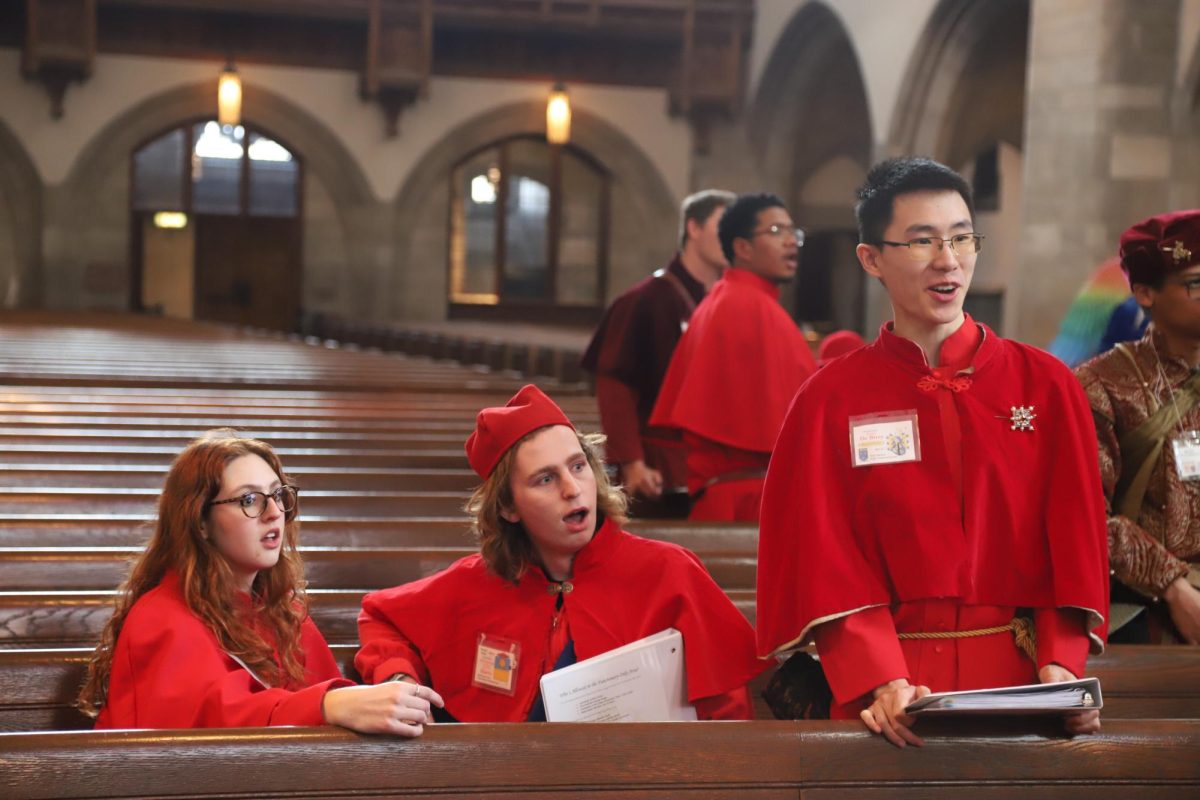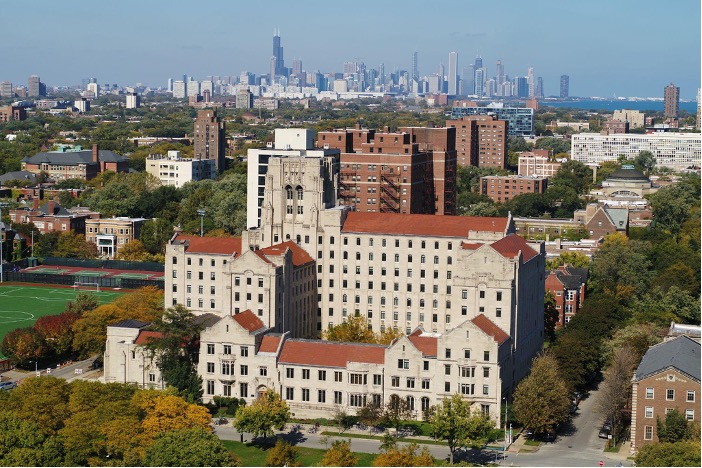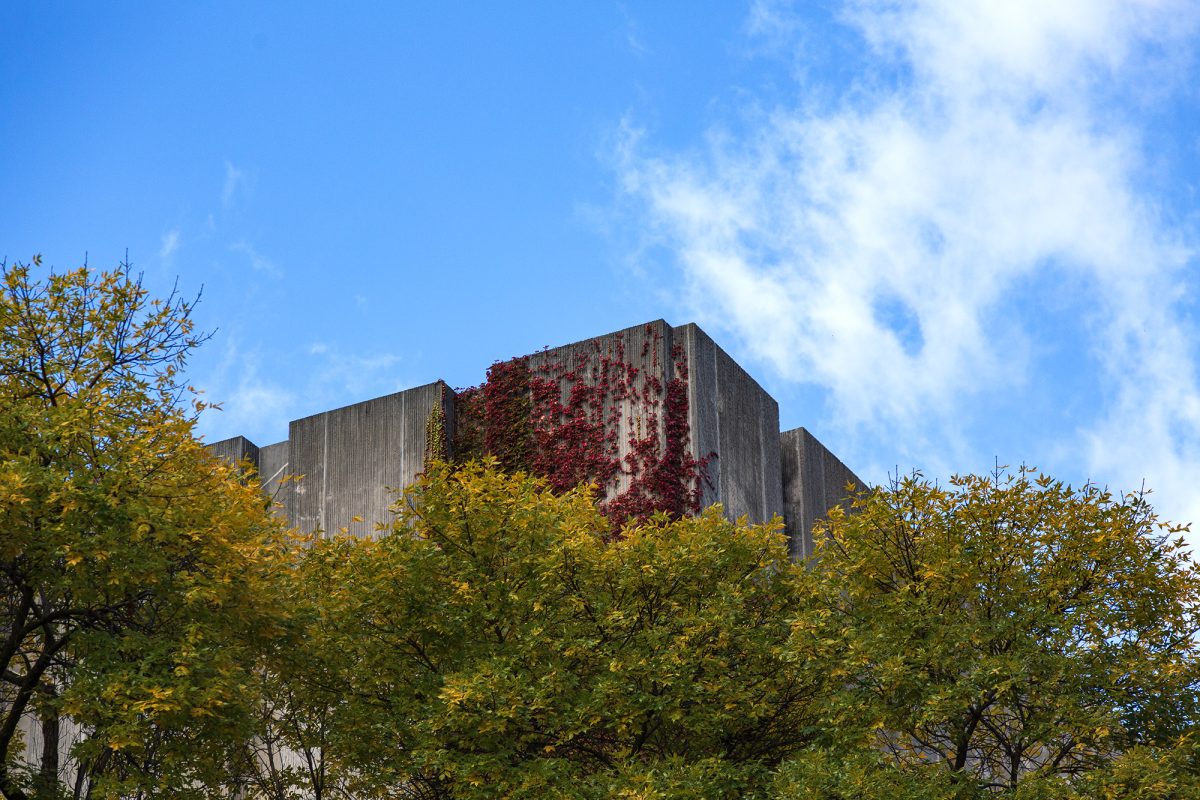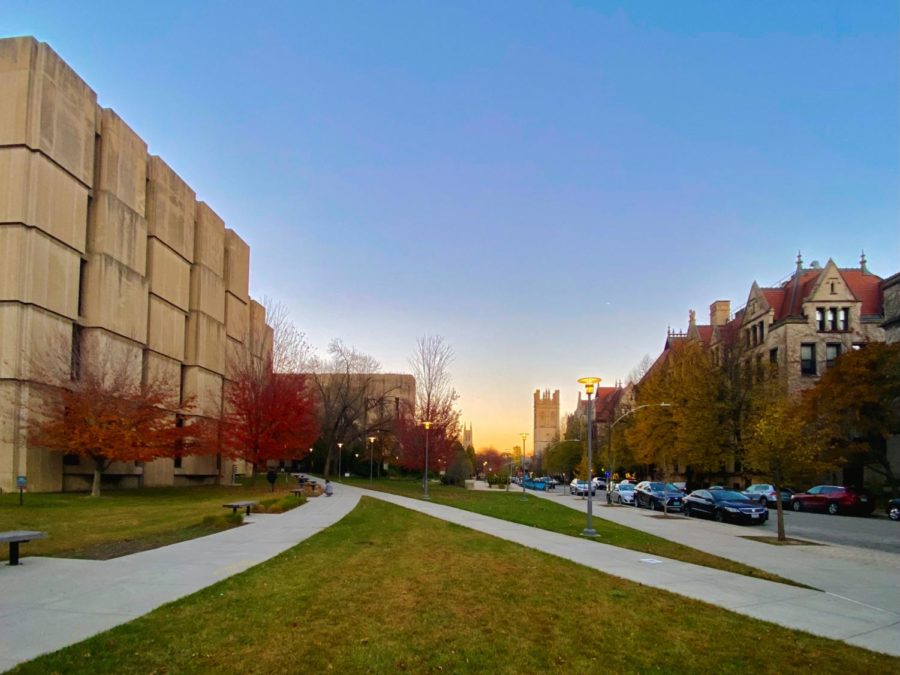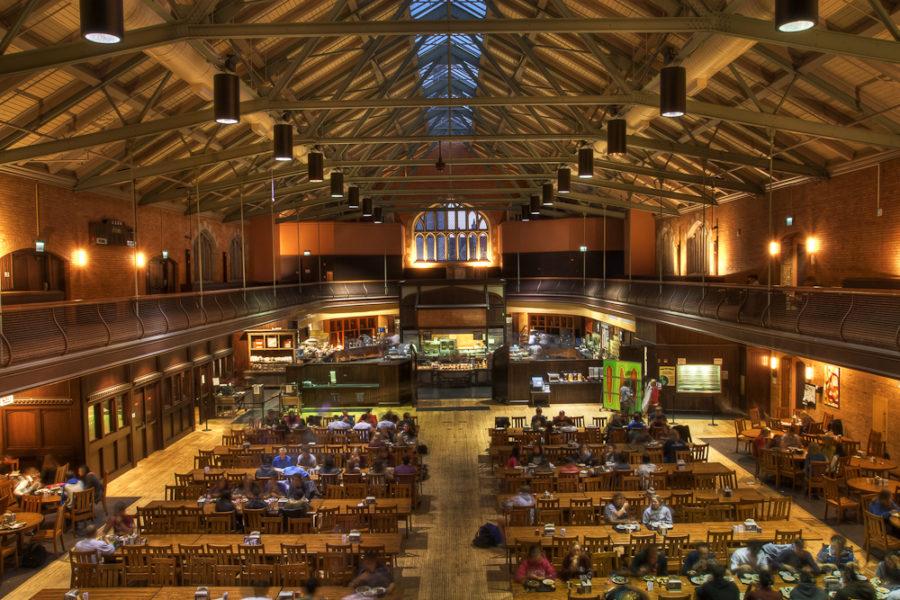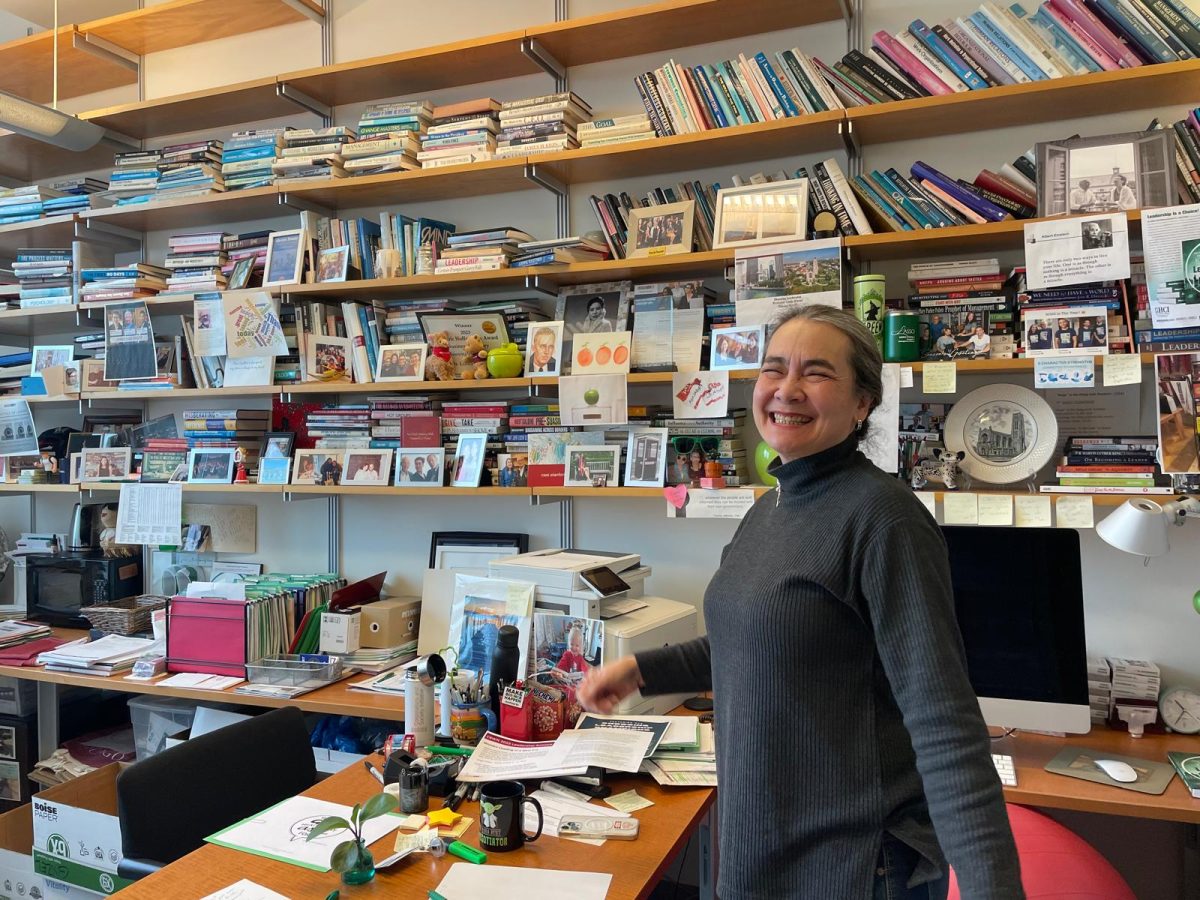The first U.S.-born pope is from Chicago and attended graduate school in Hyde Park. An underdog in the papal conclave, Cardinal Robert Prevost shocked the world when he made his debut as Pope Leo XIV from the Vatican balcony in Rome on May 8. But for some University of Chicago students, his election was part of a series of unexpected events.
Pope Francis’s death a few weeks earlier meant that, for the first time, a real papal conclave would coincide with the one held during professor Ada Palmer’s popular “pope class,” recently featured in the New York Times. Palmer has taught the class, formally titled “Italian Renaissance: Petrarch, Machiavelli, and the Wars of Popes and Kings,” for 15 years.
“We were all kind of reeling from that—like, the real Pope just died, and now we have to elect our fake pope,” recalled Emily Curran, a fourth-year who played Cardinal Ardicino della Porta Jr. in the class’s simulated conclave of 1492.
Peering into the room where it happened

The reasons behind the election of any pope are hard to parse out, and the excitement around Prevost’s nationality has only encouraged further speculation. “The selection process is so opaque. We don’t have polls and exit interviews to get a sense of why the cardinals voted the way they did,” said William Schultz, Assistant Professor of American Religions at the Divinity School. “We’ll probably get some inkling of that over the months and years to come as stories dribble out.”
But Palmer and her students have already had an insider’s look at how the closed-door selection process works, at least in the alternate universe of mystical Renaissance-era Italy. Some of them followed the present-day conclave closely, with a new perspective on power dynamics, the makings of a good papal candidate, and the role nationality plays in the selection process.
“I actually got very little sleep because I was trying to watch the chimney. I honestly thought they were going to go back for another Italian because Francis had been such a wild departure from everything that [the Church] had been,” said fourth-year Johnny Viti, who played Cardinal Giovanni Colonna in the simulation.

Of a total of 268 popes, nearly all have come from Europe, with 217 hailing from Italy. But this year, the National Catholic Reporter’s list of the 12 papal front-runners was more ethnically diverse than in previous conclaves. It included cardinals from the Democratic Republic of Congo and the Philippines, and just two contenders from Italy.
“Catholicism isn’t just about some old dudes in Europe…and a cute little old pope…who’s got the Popemobile,” Viti reflected. “It’s about the fact that the next person that they can trust to lead that church can come from any sort of background. It’s about disconnecting the spirit from the politics part.” He stressed the importance of Catholicism as a universal religion.
Indeed, the identity of “Rob Prevost,” a mild-mannered Midwesterner, has been celebrated in the news. But in many ways, Prevost doesn’t fit the mold of a stereotypical American. Like many cardinals, Prevost is multilingual and comfortable communicating in his non-English tongues. Some Italians have even begun referring to Prevost as il meno americano tra gli americani, or the least American of the Americans, for defying the loud, brazen, Anglo-centric stereotype. During Pope Francis’s synod meetings, in which Catholic leaders gathered to discuss church doctrine, Prevost was the “one who spoke least at the table,” according to José Manuel de Urquidi, a Catholic layman interviewed by the Times.
And a glance at Prevost’s record reveals that it would be a mistake to label him as liberal or conservative or even to place him on the axes of American politics, as Christian Paz of Vox points out. He has been known to adhere to church doctrine and hold political views that align with both liberal and conservative stances. He has opposed the ordination of women as deacons and warned against a “homosexual lifestyle” that distracts from church teachings. On social media, he has both advocated for gun control laws and criticized abortion, CBS News reported.
A Chicago-born Peruvian polyglot
The novelty of a North American pope has diverted attention away from Prevost’s cosmopolitan past: he spent decades living in Peru as a missionary and has dual U.S.-Peruvian citizenship.
“Most of us don’t have access to the language world that he’s been living in for the last 20 years—of Spanish, coming from Peru,” said Michael Le Chevallier, Director of National Partnerships at the Lumen Christi Institute, an independent nonprofit academic center in Hyde Park focused on Catholic studies.
Recently, Le Chevallier attended the annual Peru Forum hosted by the University of Chicago Association of Peruvian Students. “It was really striking talking to some of the Peruvians there about the very present vision they have of Leo XIV as Bishop Roberto Prevost, who used TikTok and who built an oxygen factory during COVID to provide oxygen for the most vulnerable, and who criticized the current president on Twitter [in Spanish].”

Thus far, Prevost has not leaned heavily into his (North) American identity. In his first public address, he spoke first in Italian and Latin, and then in Spanish. “He didn’t speak English,” Palmer noted in an interview with the Maroon. She called it “a very deliberate choice for somebody who is a smooth polyglot in five languages and switches all the time.” (Prevost is also fluent in Portuguese and French.)
“[Prevost] is a wise strategist of his own self-fashioning.… I think it’ll be less how we see him than how he realizes he is being seen,” she said.
She also suggested that Chicago might earn a mention in Prevost’s future sermons. “I think he will be able to use the talking point of Chicago being such a segregated city whose segregation is systemic and created by bold, deliberate structural inequalities,” she said. The pope’s childhood home sits at East 141st Place in Dolton, a working-class suburb immediately south of Chicago, where his father worked as a school superintendent and his mother was a librarian.
From 1980 to 2000, Dolton’s residents went from 94 percent white to 91 percent Black, in an example of racial turnover known as “white flight.” The village has also suffered from deindustrialization, struggling economically since the collapse of the steel industry in the 1980s; currently, one in five residents lives in poverty, according to reporting by the Chicago Sun-Times. Village residents hope that Prevost’s election will help put Dolton back on the map and give it an economic boost.
“Nowadays, the papacy isn’t as fun—or at least it’s not as worldly.”
For most of history, the idea of an American pope presiding over the coveted Throne of St. Peter was met with apprehension within Catholic orders. Until the mid-20th century, it was logistically impossible for a cardinal on the other side of the Atlantic Ocean to hold the position; steamships from the U.S. to Rome took so long that U.S. cardinals sometimes arrived too late to vote in a conclave. However, the main objection to a U.S. pope had less to do with the lengthy maritime commute and more to do with geopolitics. Cardinals had long argued that with the U.S. already a global superpower, the acquisition of religious power would be overwhelming.
“But the Vatican is no longer what it was in 1492,” Palmer said, much to the chagrin of third-year Julia Morales, who played Lucrezia Borgia and loved every moment she spent in costume.
“Nowadays? I’m not going to say the papacy isn’t as fun… but the papacy isn’t as fun—or at least it’s not as worldly,” Morales lamented.

Today, business acumen and shrewd military instincts aren’t requirements for the role. Along with the elimination of a papal army, the allure of scandal—the revolving door of mistresses, illegitimate children, the mismanagement of large amounts of funds, the plotting, scheming, and drama between political rulers and the Holy Father—is gone too.
Third-year Danny Kind, who won by a 26-vote margin as Cardinal Ascanio Sforza, said his strategy for winning was to remain honest in the face of treachery. “Given how much backstabbing every single other contender ended up doing and cheating and flubbing the votes to try to win, I think it ended up serving me well, because by the end of the vote tallies, people voted for me because I was the last person they could trust,” Kind said.
“The papacy has returned, in a way, to its original function to spiritually guide the billions of Catholics around the world, which is good, but also less entertaining. Like, can we go back to the year when there were four popes?” Morales joked. (In 1276, a series of four popes were elected, including one who died of illness before he could be ordained into the priesthood.)
Curran added that throughout the class, she realized that the pope still commands power, just of a different kind. “The Pope’s not wielding military might in the way that he was, but he’s still wielding a lot of social and cultural power,” she said.
The world watches him closely as a global role model and a public figure, “in the same way that when the Dalai Lama makes a speech, everyone pays attention,” Palmer said.

The “illusion of power”
Among the top contenders in this year’s conclave were Italian Pietro Parolin, one of Francis’s top aides, and Filipino Luis Antonio Tagle, dubbed the ‘Asian Francis’ for his approachability and attitude of acceptance toward gay Catholics.
But Viti said he learned to be wary of the “illusion of power” as Cardinal Colonna in the 1492 simulation. The candidates who commanded large voting blocks of support didn’t always have the most influence.
The lesson also applied in 2025. “You look at some of these guys like Tagle, or Parolin, who, everybody thinks, ‘Wow, they command a lot of votes.’ But at the end of the day, whether or not you’re a liberal or conservative in the Vatican isn’t really what people are voting on,” Viti said. “I found that kind of interesting, that there’s such a disconnect to us as observers.” During the 1492 simulation, characters were worried about achieving personal objectives, such as protecting their homelands, he said.
A new pope who plays his cards close to his vest and operates outside of a binary ideological framework might vex U.S. Catholics, whose views—and approval of the Pope—have grown increasingly polarized across party lines in the last five years. This divide is also evidenced by the fact that Trump won the national Catholic vote by a seven-point margin in 2024, according to the Associated Press VoteCast.
Some on the political left even interpreted the curia’s subsequent election of Prevost as a signal of the “deep concern about the global spread of fascist authoritarianism broadly and the U.S.’s financial and ideological support for that rising threat,” summarized Megan Goodwin in the online magazine Religion Dispatches.
Both internal Vatican politics as well as American politics could have played a role in Prevost’s election, according to Schultz.
“I might put it as perhaps trying to transcend the divide, and saying, ‘It’s not just left versus right. There is a Catholic alternative, and Leo represents that,’” Schultz said. “It could also have been that Prevost seemed like a good compromise candidate in a very divided electorate because most people seem to regard him as a good manager, a good consensus builder, someone that a lot of people can get behind.”
In the days leading up to the conclave, Catholic scholars and members of the religious community listed clashes between Trump and Francis and the unwelcome rise in a “new, old Catholicism” among U.S. conservatives as reasons that a pope from the Anglosphere would be virtually unthinkable. Palmer offered a different perspective. Citing her research on censorial bodies, she explained that “efforts to police truth and efforts to dictate morals are often more reactive than proactive,” suggesting it may have been precisely for those reasons that Prevost emerged as the crowd favorite.
“Prevost is well-positioned to criticize the fashionable approach of the neoconservative, far right, ‘evangelical’ Catholic—if you can call them that—that is this fad within the U.S.,” she said.
Young conservative Catholic converts in the U.S. are reshaping the American flock. In a movement “personified by JD Vance,” per the Washington Post, conservative Catholics see themselves as traditionalists. They’ve called for a return to practices such as the Traditional Latin Mass of the late 1500s, Gregorian chants, and women wearing veils. Associated Press National Correspondent Tim Sullivan sees this shift toward orthodoxy as a rejection of the Church’s move toward a more liberal doctrine as it attempts to adapt to the modern, secularized world. As a consequence, he writes, conservative Catholics have found themselves at odds with the rest of the Catholic world.
However, it would be wrong to reduce the Church’s decision to a response to the American religious and political landscapes, according to Chevallier.
“I don’t think that the Church sees things on the election cycle of American politics,” Chevallier said. But he added: “[Leo] will represent a papacy that understands the American experience, both in its flaws and in its virtues.”
Pope Leo’s first homily contrasted the security of the Christian faith with the securities of “technology, money, success, power or pleasure,” denouncing the tendency of “many baptized Christians who… end up living at this level in a state of practical atheism.” He has previously publicly criticized JD Vance’s belief in a hierarchy of Christian love and defended Francis in denouncing Trump’s anti-immigration rhetoric.
In doing so, Prevost has largely affirmed expectations that he will carry on the previous pontiff’s legacy.
A continuity pope, kind of
When Argentinian Pope Francis was elected a decade ago, the Catholic church was facing a different threat. In 2013, the selection of Francis was widely understood as an acknowledgment from the Church that it needed to broaden its reach to the Global South, where nearly 40 percent of its followers reside.
“[The Church was] addressing the perceived crisis of demographics,” Palmer said. “At this point, the vast majority of Catholics are living in the developing world and a lot of them in the southern hemisphere, arenas that have never been represented by a European papacy.”
This year’s conclave was the “least European” after Pope Francis left the College of Cardinals with 82 of 133 who are non-European appointees, the largest number to date.
As promised, Francis “flung open the doors of the church” to groups that he saw as previously marginalized and stigmatized due to the curia’s Eurocentric “inward-looking religiosity.” Francis ushered in a new era as the first non-European in over a millennium and the only member of the Jesuit order to become pope. He called on the world to welcome immigrants and embrace the poor; in a notable example, he delivered gelato to prisoners during 2021, Rome’s hottest summer on record.
“Several of us were rooting for Tagle, the Filipino cardinal, because he was essentially just a continuation of Francis, like, he had the exact same beliefs,” said fourth-year Kevin Davis, who played Cardinal Ippolito d’Este.

Like his predecessor, Prevost has advocated for unity within the Church and assumed a conciliatory tone toward those with differing religious philosophies. However, he has taken a more measured approach by remaining mostly quiet on certain issues, such as the legitimacy of same-sex unions.
Still, observers on all ends of the political spectrum have speculated about Prevost’s vision for the Church, for example, by reading into his choice of pontifical name.
The late Pope Leo XIII was a staunch advocate of workers’ rights and the first pope who didn’t have control of the Papal States. Putting down the scepter, he instead took up the pen, issuing over 80 encyclicals, or letters sent to all bishops of the Roman Catholic Church, during his tenure.
In 1891, Leo XIII published an encyclical, titled “Rerum Novarum,” or, “Of New Things.” The letter was a major indictment of the capitalist exploitation of human labor, arguing that the right to labor unions was a civil and sacred right of all humans.
“We can see that the current Leo, with the name he’s taken, sees this era as being similar to the industrial transformation that Leo XIII was writing about,” Schultz said. “Only now, instead of dignity being threatened by the factory system, it’s threatened by things like artificial intelligence.”
In a papal bull, a more official decree issued by the Church, Leo XIII raised concerns about “Americanism,” a perceived heresy based in a cultural liberalism that allowed Catholics to selectively follow Church doctrines. Even those who didn’t call it an outright heresy feared that the American Catholic Church was trying to go its own way, deviating too far from the more conservative Vatican of the time.
“Leo, like Francis before him, confronts, in some ways, a similar situation, which is a feeling that the Catholic Church, or at least the leadership, the bishops and cardinals of the Catholic Church in the United States, are trying to separate themselves from the back end,” Schultz said. “But whereas in the earlier version, the fear was that the American Catholic Church was too liberal, too progressive, now for Francis and possibly for Leo as well, there’s the fear that it’s too conservative and too aligned with the Republican Party and right-wing politics.”
A papal blessing for struggling Chicago sports teams
Putting politics aside—as Prevost seems to favor—the election of a Chicagoan pope has riled up local sports fanatics.
When Prevost’s papacy was announced, Chicagoans wasted no time creating memes, scouring the internet for clues of his favorite teams. His brother finally put an end to the debate over which baseball team his sibling supported by confirming that the Holy Father was a White Sox fan.
“That interview they did with the Pope’s brother was the most Chicago interview ever. This guy with a very thick Midwestern accent is like, ‘Yeah, you know, they’re saying he’s a Cubs fan. I don’t know where they got that from. That’s just wrong. He’s a Sox fan.’ It makes me very happy. The new pope is a Sox fan,” Kind said.
“I’ve seen T-shirts going around that have been like, ‘Habemus Papum Go Sox!’ And I think it’s just highly amusing to me,” said Curran.
Students had varied levels of optimism about whether a blessing from the pope could change the trajectory of a team with record losses in 2024.
“We have a winning record under the new papacy. So I think things are looking up,” Davis said. (This is no longer true at the time of publication.) At a recent game, the White Sox scored a home run in the first inning, and Davis and his friends made sure to thank the Pope in their cheers.
“We’re still talking about the Chicago White Sox here. Okay, I think, maybe, let’s manage your expectations. I wouldn’t hold out for some miracle,” Kind countered.
Football fans were also hopeful. “He’s a Bears fan, and the Bears need as much help as they can get,” Davis said.
But Palmer thinks the Holy Father’s Midwestern ties could bless Chicago with more than just better outcomes for its struggling sports teams.
She predicts that a papal visit is likely. She didn’t comment on the timing of the visit, which could determine Prevost’s chances of meeting one of UChicago’s future popes.
“I wouldn’t be surprised if he came by Hyde Park, because he used to live here, and was educated in the building directly across the street from my apartment,” Palmer said.



